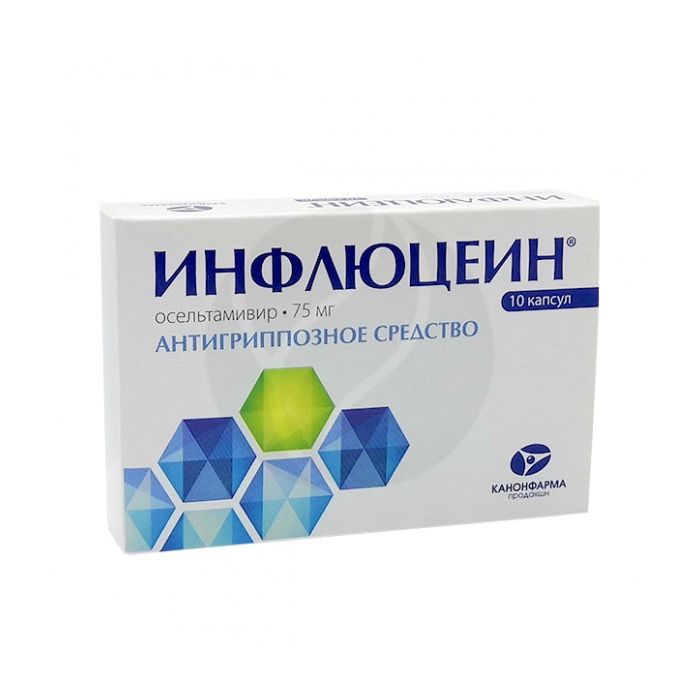Influcein capsules 75mg, No. 10
Expiration Date: 05/2027
Russian Pharmacy name:
Инфлюцеин капсулы 75мг, №10
It is taken orally, regardless of food intake. During treatment, the intake should be started no later than 2 days from the moment the symptoms of the disease develop at a dose of 75 mg 2 times / day for 5 days. An increase in the dose of more than 150 mg / day does not lead to an increase in the effect. For the prevention of influenza types A and B in adults - 75 mg 1-2 times / day for 6 weeks. (during a flu epidemic). The maximum daily dose for adults is 150 mg. In patients with CC less than 30 ml / min, the dose is reduced to 75 mg 1 time / day for 5 days.
Capsules are hard, gelatinous, No. 1; yellow lid, white body; the contents of the capsules are a mixture of granules and powder of an almost white color or a pressed mass of almost white color, crumbling when lightly pressed.
1 caps.
oseltamivir phosphate 98.5 mg,?
which corresponds to the content of oseltamivir 75 mg
Excipients: calcium hydrogen phosphate - 25 mg, pregelatinized corn starch - 46.3 mg, croscarmellose sodium - 7.2 mg, sodium stearyl fumarate - 1.5 mg, talc - 1.5 mg.
Chronic renal failure (CC less than 10 ml / min),
liver failure,
hypersensitivity to oseltamivir.
pharmachologic effect
Antiviral agent. It is a prodrug, the active metabolite (oseltamivir carboxylate) of which selectively inhibits the neuraminidase of influenza A and B viruses. Neuraminidase is a glycoprotein that catalyzes the cleavage of the bond between terminal sialic acid and sugar, thereby promoting the spread of the virus in the respiratory tract (the release of virions from infected cells and penetration into the epithelial cells of the respiratory tract, preventing the inactivation of the virus by epithelial mucus). Oseltamivir carboxylate acts outside cells and competitively inhibits viral neuraminidase. It inhibits the growth of the influenza virus in vitro and suppresses the replication of the virus and its pathogenicity in vivo. Reduces the excretion of influenza A and B viruses from the body. Does not interfere with antibody production in response to inactivated influenza vaccine.The resistance rate of clinical virus isolates is 2%.
Pharmacokinetics
After oral administration, it is almost completely absorbed from the gastrointestinal tract, absorption does not depend on food intake. Has a 'first pass' effect through the liver. Under the influence of intestinal and hepatic esterases, it turns into an active metabolite. 75% of the dose taken orally enters the systemic circulation in the form of an active metabolite, less than 5% - in the form of a starting substance. Plasma concentrations of both the prodrug and the active metabolite are dose-proportional. The average Vd of the active metabolite is 23 liters. Plasma protein binding - 3%. It is excreted as an active metabolite mainly by the kidneys by glomerular filtration and tubular secretion. T1 / 2 of oseltamivir - 1-3 hours. Oseltamivir carboxylate is not further metabolized and excreted by the kidneys, its T1 / 2 is 6-10 hours. Renal clearance is 18.8 l / h. It is excreted through the intestines - less than 20%.In elderly patients (65-78 years), the concentration of the active metabolite in the equilibrium state is 25-35% higher than in younger patients. In patients with renal insufficiency, the rate of elimination of oseltamivir carboxylate is inversely proportional to the CC value.
Side effect
From the digestive system: nausea, vomiting (usually when taken in high doses, or in the first days of treatment); rarely - diarrhea, abdominal pain. From the side of the central nervous system: insomnia, dizziness, headache. From the respiratory system: nasal congestion, sore throat, cough. Others: feeling tired, weak.
Application during pregnancy and lactation
Use with caution during pregnancy and lactation.
Application for violations of liver function
Contraindicated in hepatic impairment (in patients with hepatic impairment, the safety and efficacy of oseltamivir has not been established).
Application for impaired renal function
Contraindicated in chronic renal failure (CC less than 10 ml / min). In patients with CC less than 30 ml / min, the dose is reduced to 75 mg 1 time / day for 5 days.
Application in children
Use with caution in children.
special instructions
Use with caution in children. In patients with hepatic impairment, the safety and efficacy of oseltamivir has not been established. There is no data on the safety of using oseltamivir with CC less than 10 ml / min.
Drug interactions
Medicines blocking tubular secretion increase the concentration of the active metabolite by 2-3 times (due to inhibition of the process of active tubular secretion in the kidneys), which does not require dose adjustment.

